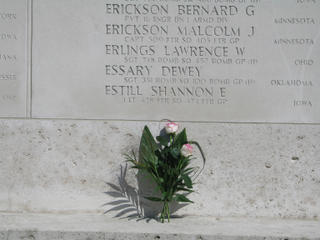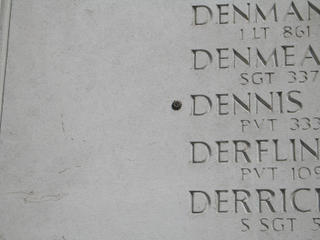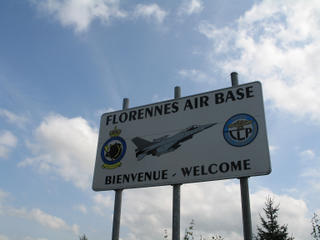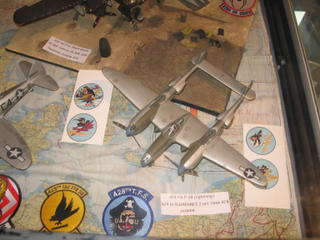 Wall of the Missing Margraten
Wall of the Missing Margraten Wall from a distance
Wall from a distance Symmetry
Symmetry Rosette = Found
Rosette = Found Inscriptions at memorial
Inscriptions at memorial
 Hans-Guenther & Ernst
Hans-Guenther & Ernst
 Abby de Maredret
Abby de Maredret Formerly Louie's place
Formerly Louie's place Ernst with helpful Belgian
Ernst with helpful Belgian At the gate to chateau
At the gate to chateau Chateau entry road
Chateau entry road Florennes Airbase
Florennes Airbase


The Eifel, Margraten, Falaen, Florennes, Aachen and beyond, September 4-10, 2005: In the week since I’ve been in West Germany, I have gathered new threads into the fabric of my father’s story. I knew when I planned this hopeful itinerary that I would want to collect the last missing impressions of my father’s life before his fateful flight in April, 1945. That included a visit to the American War Cemetery in Margraten, Holland, and a last attempt of three to find the elusive, now-demolished, Chateau le Beauchene. Enfolded in those plans, was my primary agenda which was to learn the procedure to have a bronze rosette placed next to my father’s name on the Wall of the Missing in the American Cemetery in Margraten. I remembered noticing the rosettes on my last trip with Hans-Guenther and feeling a twinge of envy and wonder for those whose knowing families. There is no cachet inherent in living without answers – the rosettes placed beside those names designate a solemn resolution of doubt. I wanted that resolution.
It was a very different visit this time to Margraten. First, I knew to purchase flowers in Aachen enroute to Holland. For my father’s place at the bottom of the Wall of the Missing in the section where all the names begin with the letter “E,” I chose two cream and peach roses with pink petal tips – from my mother and me. For my friend’s uncle’s grave, I chose a bouquet of unusual fragrance. I looked very purposeful with my bundles of blumen wrapped in yellow paper – a woman on a mission.
For me, war cemeteries evoke conflicting feelings. It is impossible not to be impressed with the sheer symmetry of the place. The geometric possibilities, to say nothing of the advanced planning, plotting, and planting necessary to achieve this result, are endless and astonishing. The Wall with the A-Z names of the unfound souls is, much like the Viet Nam Wall in its cause for humility in the shadow of these simple names and home states. Each inscription is individual but identical. The first time, I made a rubbing on paper as I’ve seen people do at the Viet Nam wall, and hoped to one day know what happened to my father. This time, as I placed the two roses beneath his name, I realized my father was no longer missing. It was there, in that orderly place – everything in a line and suspended in black marble, that I sensed the sacred passage of time and the accomplishment at Elsnig.
I ventured into the field of endless crosses to put the other bouquet at the site of a friend’s uncle. I stopped at the gravesites of the others from my father’s squadron and fighter group. Hans-Guenther kindly provided a list of each man from the group and found our way to the crosses. I recognized some of the names from my father’s letters. He flew and died with friends.
Amidst my conflicting feelings lay a paradox in that Margraten experience. Though a sense of extreme order and beauty exists in the place – everything is, by design, perfectly symmetrical – I recognized the contradiction. The evidence found in the dirt of the humble Elsnig field belied this sense of perfection and peace. It told, if you will, the back story to what I saw at Margraten. Elsnig was the reality, the event, the coming apart of a life with the concurrent ripple across time for all generations who follow. The field in Elsnig held the evidence of a catastrophic violent event wherein everything was destroyed beyond ordinary recognition. Everything was obliterated or reduced to its most common denominator – pieces, rubble, and melt. It was a shocking and horrific event, as all war deaths are, even the single sniper’s accurate shot in the middle of the day that finds its mark.
As I stood entranced by the variations of the patterns in the planned order of the Margraten Cemetery, flashes of Elsnig intruded. I saw it all as if I were watching a split screen: on one side the measured order of Margraten’s endless crosses and on the other the shattered intrusive reality of each person buried there. Perhaps because I had just come from the other side of the screen, I felt a twinge of anger at the injustice of it all. Why, I wondered, are we still going to war? Haven’t we learned that this is the inevitable outcome? Why is this still acceptable? I grieved more at that realization than any one before it. The names of the people who are buried there and those who are not, all became as important to me as my father’s name listed among them. As if I heard a collective sigh, I told them they were not forgotten. The sad truth of it is that I didn’t know (nor did my mother or my father’s parents or siblings) that my father’s name was even ON the wall at Margraten until I met the men of his squadron a little more than a decade ago. [My soapbox is officially re-folded and back in the corner]
All of this happened on September 5. On September 7, my thoughts were divided between two young men, close to the same age and of certain kindred spirit. One was celebrating his 28th birthday and walks on the cusp of his own success as an emerging and important artist. The other was killed in Iraq last year on this day as he stood by his jeep with the people he held in his care and command. Both of these brilliant and shining souls bring light and hope to our world. One just gets to do it on this level for a while longer and the other has moved ahead of us but is missed and loved by many people including me, who attended his memorial service and gained a precious friend in the process. Here’s to Justin and Tim on this auspicious day! A German beer is raised in your honor on September 7 now and forever!
From Margraten, we made another day-trip to Belgium in search of the chateau, the Abby and the airfield. Chateau le Beauchene was located just a few kilometers (within walking distance according to my father’s letters) from the village of Falaen. Falaen was the home of Louis’ Pub in which my father’s squadron (known locally as the “wild boys”) spent endless hours and Belgian francs. Haircuts were also available.
We arrived in Falaen and one of two men on the street knew exactly where the chateau was located, when it existed. He immediately led us there (a long walk by anyone’s standards so we drove) and escorted us into the woods asking us to imagine (in French, translation courtesy of the ever-talented & multi-lingual, Ernst) that the entry was just beyond this half of the gate still remaining and that the chateau sat just “here” to the left and overlooked a field that is just behind all those 60-year old trees. You get the picture. I walked down the road that was certainly the same road my father and his squadron mates walked a million times to come and go to Louie’s or to the Abby or just for a walk. Certainly, their transport trucks took them to their airfield from that same road. I felt the collision of recognition and familiarity as if my father was walking with me. I strongly sensed his presence again at the Abby later that day. We made our way from the chateau site deep in discussion about the validity of the accommodating Belgian man’s information. His directions were validated by an excellent detailed map prepared for me several years ago by one of my honorary fathers, Jack Zaverl, for just this occasion. His diagrams and descriptions are artful and exact.
Our next stop was the Abby de Maredret where my father attended Mass and befriended the nuns-in-residence throughout his stay at the chateau. He wrote often of his trips to the Abby and of buying my mother and his mother a St. Theresa medal, the patron of flyers, identical to his own. As odd luck would have it, we couldn’t actually enter the church, though I had visited it with HG on a prior visit. I did manage to find a St. Theresa medal, however, which now occupies the same chain as my tiny silver P-38.
Louie’s has been sold to a new owner who may or may not remember the Geyser Gang of the 428th Fighter Squadron. Though the façade of the place has changed, there is a small garage to the right of the entrance that reads, Garage Louis, in pale blue letters.
The surprise excursion of the day was at the suggestion of Hans-Guenther who had a Spitfire Museum in mind. We wound our way from the Abby to Florennes Airfield (known as, A78 in my father’s time) to see what remained of the airfield from which my father and his squadron flew their missions. It remains a viable air base today with F-16s constantly flying into and out of the very active field. We managed with the help again of Ernst’s French, to get onto the base as long as we only visited the Spitfire Museum. The surprise was within. The display cases surrounding an actual Spitfire, contained photographs and acknowledgement of the presence in the late 1940’s of the 474th USAAC Fighter Group. The Disney squadron insignia and the group insignia were all there along with photos (identified in French, of course) of anyone who had contributed to the display. I presented a photo of my father to the museum curator and asked that it be placed in the display. They offered to make an entire page about my father in the memory books they keep there. It was a good day made better by unexpected gifts.
I was enchanted by a brief, but relaxing, respite in the Eifel Mountains near Ernst and wife, Helga’s, meticulously restored (the hard way: brick by brick) farmhouse. From there, we made the trips to Holland and Belgium and from there that I traveled to Frankfurt, to London, and next week, home. My next trip is the 474th Reunion in Salt Lake City the weekend after I return home. Der Spiegel TV is coming to film the event and interview the guys who flew with my father. They also intend to film my presentation on Friday night which will hopefully be finished in pristine Power Point format by the time I touch down in Phoenix. One of my Estill cousins will meet me at the reunion and I have Team Estill hats to distribute that are sewn on the back with the inscription, Honorary Dad. This reunion is dedicated to the families of the squadron members. As always, when I attend these reunions, I am conscious of the gathering of angels just at the edges of the crowd – watching us thoughtfully and knowing all the answers to the things about which we can only wonder. This will be the first reunion without my most honorary dad, Bill Capron. I’ll save you a place at my table, Bill, and tell you the story myself.
I don’t know if I included this correction in the last post, but the correct address for Hans-Guenther’s website is: http://www.cablecutter.de/ The other one is the site for his aircraft parts collection.
